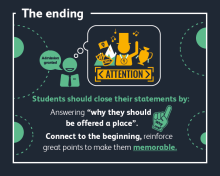
'Personal statements give applicants the opportunity to articulate why they’d be an asset to the university. It also helps universities understand and connect with the person behind the grades.'
You can help your students stand out with a tailored and succinct personal statement that demonstrates the individual they are.
You already know how important a personal statement is in supporting your student’s university applications. You understand it’s their chance to get noticed for the unique talents and experiences they have. And yet you see so many of them overwhelmed with the task of writing it.
In this guide, we’ll walk you through a step-by-step process you can use to support students in writing a personal statement they can be proud of.
Supporting students applying for 2026 entry? We've created guidance and resources to help with the transition to the new format of the personal statement. Whilst the content students are expected to include remains broadly the same, the format is changing to three separate questions. This means that the guidance on this page is still applicable, but will need to be thought of in terms of the three new questions.

'Personal statements give applicants the opportunity to articulate why they’d be an asset to the university. It also helps universities understand and connect with the person behind the grades.'
You’ll have heard the saying preparation is key, and that’s important when building a personal statement.
Before a student starts writing anything, encourage them to do some planning by noting down the answers to some simple questions.
Now they have a great set of notes and something tangible to get them started.
There are plenty of classroom activities, tools and expert-endorsed techniques you can use to help students too.
Try these three different activities to get students in the right frame of mind for writing their personal statement:
Ask your class to contribute ideas about what they think the university admissions tutor is looking for in a prospective student. Hardworking? Committed? Motivated? Now ask them to write an example of how they demonstrate each attribute and to share it with the class. If they get stuck, they might pick up ideas from their classmates and realise they do have a concrete example.
Ask students to write down personal experiences they think would support their university application. Then, in pairs, one student can go through their list of experiences, while the other says ‘so what?’ until the first student can explain why it’s useful and relevant to their application.
Create some long-winded personal statements. Read out each statement and get students to raise their hand when their ‘waffle detector gland’ is set off. Then discuss how it could be improved. Let them practise how to cut things down to be more precise by challenging them to remove words that add no value.

Now you’ve helped them with making notes and walked them through some useful activities, you can offer further support by giving advice around each section of the personal statement.
Advisors give their advice to teachers on how to help their students write a great personal statement.
Students will often find the opening of the personal statement the hardest, so giving them simple advice is best here. They need to stand out from the start to keep the attention of the admissions tutor, so they may feel pressure to get it exactly right.
Here are three main pieces of advice:
You can also direct students to a full guide on How to start a personal statement: The attention grabber.
When students are talking about the course and subject, they’ll need to cover four main areas:
They’ll now need to write about their personal skills and achievements. Beware, this is where the waffle detector is often needed. They’ll need to be mindful to keep this part relevant and useful, so it complements the rest of the statement.
Here’s some examples of advice you could give:
Work experience and future plans are important in a personal statement. Suggest they share details of jobs, placements, work experience, or voluntary work, particularly if it's relevant to their course.
It’s always good to connect the beginning of a statement to the end, as it reinforces what they said at the start. The ending should make an admissions tutor remember the applicant.
This final part of a personal statement should emphasise the great points already made and answer the question of why this applicant should be offered a place on the course.
You can direct your students to our full guide on how to end your statement.

When your students have finished writing their personal statements, it’s time to make sure they’ve gone through the final checks. This part will make them feel more confident when they submit their statement.

Your students can also use their personal statements as a base for apprenticeship applications, CVs and covering letters. Read our advice here.
Direct students to UCAS’ personal statement tool to help them structure their ideas.
Show students our full list of personal statement dos and don’ts.